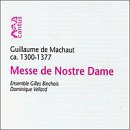| All Artists: Emmanuel Bonnardot, Philippe Balloy, Jacques Bona, Gregorian Chant, Guillaume de Machaut, Andreas Scholl, Ensemble Gilles Binchois, Dominique Vellard, Gerd Türk, Herve Lamy, Willem de Waal Title: Machaut: Messe de Nostre Dame /Ensemble Gilles Binchois · Vellard Members Wishing: 1 Total Copies: 0 Label: Cantus Original Release Date: 1/1/2000 Re-Release Date: 3/1/2000 Genres: Pop, Classical Styles: Vocal Pop, Opera & Classical Vocal, Historical Periods, Early Music Number of Discs: 1 SwapaCD Credits: 1 UPC: 675754144722 |
Search - Emmanuel Bonnardot, Philippe Balloy, Jacques Bona :: Machaut: Messe de Nostre Dame /Ensemble Gilles Binchois · Vellard
 | Emmanuel Bonnardot, Philippe Balloy, Jacques Bona Machaut: Messe de Nostre Dame /Ensemble Gilles Binchois · Vellard Genres: Pop, Classical
|
Larger Image |
CD Details |
CD ReviewsHigh plainchant sung perfectly J. R. Gunsell | Cambridge, UK | 11/05/2000 (5 out of 5 stars) "In addition to its uniqueness as a survivor, this is one of the best of all examples of "high" plainchant and here it is sung almost perfectly. Well, perfectly. Unfussily, unselfconsciously, letting the music speak for itself. I grew up soaked in this sound, mostly sung by monks, good musicians on the whole, but not this good. It delights me that the EM movement and the Solesmes movement have combined to revive this music in recordings, and that some of the best performers of the day are involved. And that it is now better known and more popular than formerly. This is a very sensitive recording. The church acoustic is clearly audible but does not intrude. This is the right balance for a Mass, which the composer and contemporary audience would not have thought of as *mere* performance. The engineers have captured the authentic sound of a church *service* as opposed to that of a *performance in a church*. By contrast, Maddalena ai Piedi di Cristo comes to mind. That is very much a performance piece, not a worship piece. In that very clever recording, the effect (which I like very much though some do not) is spectacularly echo-y, like much music recorded in San Marco. I often wonder to what extent the special acoustic qualities of that building were a designed-in part of some music specifically written for it. Gardiner makes much of it in his Monteverdi Vespers. Vespers, one might say, is a less sacred service than the Mass, and so it makes me smile to think that perhaps Claudio M. felt free to use every trick in the book to impress, somehow, anyhow, with his Vespers. (I am not a scholar, but I have a lot of fun!) The Cantus booklet is a real bonus: exhaustive notes, full of useful information - a good monograph, in fact, on the mass music of the period and the piece itself. Cantus has done a very good thing here."
|

 Track Listings (17) - Disc #1
Track Listings (17) - Disc #1